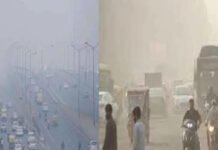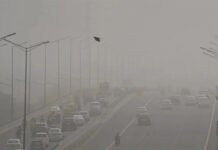A consistent spell of rainfall has drenched Delhi-NCR since the beginning of August, providing much-needed relief from the oppressive July humidity. According to the India Meteorological Department (IMD), the wet weather is here to stay, with light to moderate rainfall predicted daily until August 3. While the monsoon showers have cooled the city, they have also brought traffic chaos, waterlogging, and commuter delays across the National Capital Region.
Continuous Rainfall Since Wednesday: Relief and Disruption Hand-in-Hand
The rainy streak began on Wednesday, with dark clouds dominating Delhi’s skyline and consistent showers making their presence felt across the city. Safdarjung Observatory, Delhi’s key weather station, recorded 39.1 mm rainfall between Wednesday 8:30 AM and Thursday 8:30 AM. By 5:30 AM on Thursday, the city had already received an additional 16.6 mm of rain.
Other areas also saw significant rainfall totals:
Palam: 79 mm
Najafgarh: 61 mm
Aya Nagar: 51.1 mm
Ridge: 34.4 mm
Rajghat: 9.8 mm
Lodhi Road: 9.3 mm
Pusa: 9 mm
The maximum temperature on Thursday was recorded at 29.9°C, which is 4.5 degrees below the seasonal average, while the minimum temperature dropped to 24.7°C, 2.4 degrees below normal. The humidity remained extremely high, fluctuating between 98% and 100%, enhancing the damp feel in the air.
Delhi-NCR Braces for Week-Long Rain Spell
As per IMD forecasts, rain will continue in the Delhi-NCR region through the week. From Saturday to Wednesday, residents should expect light to moderate showers, accompanied by occasional thunder.
Here’s a breakdown of expected temperatures for the coming days:
| Day | Max Temperature (°C) | Min Temperature (°C) |
|---|---|---|
| Saturday | 34 – 36 | 24 – 26 |
| Sunday | 33 – 35 | 24 – 26 |
| Monday | 34 – 36 | 23 – 25 |
| Tuesday | 33 – 35 | 23 – 25 |
| Wednesday | 32 – 34 | 23 – 25 |
Intermittent showers are expected to disrupt traffic, especially during morning and evening hours. Authorities have urged commuters to plan their travel with buffer time and stay updated on road closures and diversions.
Commuters Face Traffic Woes, Waterlogging Across Key Areas
While the rains have brought respite from the scorching heat, they have also crippled city mobility. On Thursday morning, commuters in South Delhi, East Delhi, and parts of Gurugram reported bumper-to-bumper traffic and waist-deep water in underpasses.
Key roads such as Ring Road, Outer Ring Road, ITO Crossing, and Delhi-Noida-Delhi Flyway experienced vehicle pile-ups and snail-paced traffic. Office-goers, school children, and college students were caught in long traffic snarls, particularly during peak hours.
Civic agencies were seen deploying water pumps and quick response teams, but inadequate drainage and clogged sewers rendered efforts insufficient in several localities.
July 2025 in Delhi: More Rainy Days, Less Rainfall
According to the IMD’s gridded data, July 2025 witnessed an unusually high number of rainy days, although the cumulative rainfall wasn’t record-breaking. Out of the 31 days in July, rain was reported on 23 days, making it the 22nd rainiest July since 1901 in terms of frequency of rainy days.
Rainfall Data Comparison:
July Rainfall (2025): 150.5 mm
LPA (Long Period Average): 174.9 mm
Departure from LPA: -14%
Despite more rainy days, total rainfall was 14% lower than the 1971–2020 LPA. However, when comparing it to older records (1901–1950), July 2025 recorded 26.2% more rainy days than the historical average, signaling a significant shift in rainfall distribution patterns.
Rainfall Since June: Capital Exceeds Monthly Average
Delhi has already surpassed its monthly average rainfall figures for June and July combined. Here’s a quick summary:
Rainfall since June 1, 2025: 337.2 mm
Normal Average for this period: 270.1 mm
Excess Rainfall: +24%
Notably, 259.3 mm of rainfall was recorded in July alone, against the normal July average of 209.7 mm. This spike indicates above-normal monsoon activity, although the city has not yet approached record-breaking precipitation totals.
Why This Rain Pattern Matters
While July typically records one of the highest average rainfall totals of the year in Delhi, 2025’s distribution has highlighted shifting monsoon dynamics. More days with rain, but lesser intensity, indicates frequent, low-volume precipitation rather than intense spells. This pattern is crucial for agricultural planning, urban water management, and infrastructure resilience.
Additionally, the clash between moderate rain and poor urban drainage has exposed vulnerabilities in the city’s sewage and stormwater disposal systems. As the monsoon progresses, civic bodies must focus on proactive cleaning, desilting, and maintenance to prevent further urban flooding.
Outlook Beyond August 3: What to Expect
Although current forecasts limit predictions to August 3, early indicators suggest that rain activity may reduce gradually in the second week of August. However, localized showers and thunderstorms are likely to persist due to prevailing monsoon troughs and western disturbances interacting over North India.
Weather experts are also monitoring cyclonic circulations over the Bay of Bengal, which could influence rain patterns in the northern plains, including Delhi, Haryana, and Uttar Pradesh.
Precautions for Residents During Continuous Rain
Given the ongoing rainfall, Delhi-NCR residents are advised to:
Avoid low-lying areas prone to waterlogging
Check traffic updates before traveling
Use public transport wherever feasible
Secure loose outdoor objects and electrical fixtures
Stay alert to IMD weather bulletins and advisories
Schools and offices have also been urged to consider staggered timings or remote work options to reduce congestion during peak downpours.
Conclusion: Rain to Stay, City Must Adapt
Delhi-NCR’s pleasant weather and moderate temperatures are a welcome break, but the urban chaos caused by rains underscores the urgent need for monsoon-resilient infrastructure. With forecasts confirming the continuation of rains till August 3, authorities and citizens must remain vigilant and adaptive.
As the monsoon plays its part in refreshing the capital, Delhi must find a way to balance its blessings and burdens—embracing the rain while bracing for its challenges.
















